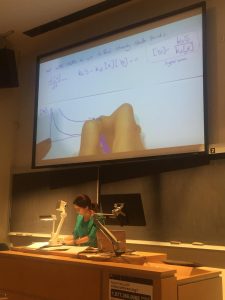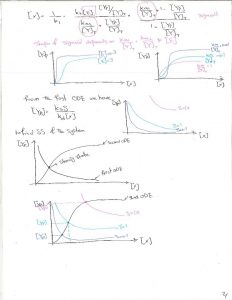I have TAed this course twice: 2019 (spring) and 2020 (spring). My responsibilities include assisting students in the course project, marking their midterms and designing the course project to be implemented in the computational lab sessions allocated for this course. I spend 2hr/week in the lab and 2hr/week preparing the lab contents, 10hr marking midterms and 4hr invigilating the exam; which adds up to total of 72hr/term for 60 students (in 2019) and 95 students (in 2020) in the second-year biomedical engineering program who register in this course.
- Teaching Approach
As part of my professional development in my TA role, I gave 5 hours of lecture for BMEG250. For these lectures I was given the opportunity to design and deliver the content. For two of these lectures, I used a Powerpoint slide deck with graphical representation of the concepts while for those mathematics-heavy lectures I decided to use a combination of tools including the document camera and blackboard as well as slides to present the graphical results of the mathematical models. I believe this approach would give students enough time to work on the derivation of the equations and solving them as I am proceeding through the lecture. To make the math more tangible and understandable for the students, I start my lectures by introducing some real word concepts related to the lecture content. For example, for the lecture on mathematical modeling of positive and negative feedback systems in the body, I start with an example of fear reaction when someone sees a bear and asks students what happens when th

e person feels the fear. Then I guide the conversation to what happens at the molecular level and how the body generates the run, hide or fight responses. I focus on how the concentration of the molecules involved in each of these states changes with time and then introduces the derivation of the ordinary differential equations governing the process. Once driven, I walk students through the analytical as well as numerical approaches to solve the system, using the tools already taught in the other lecture, I encourage the students to try solving the system by themselves. Then I discuss the implication of this model to other more complicated systems involving multiple cascades of feedback to build upon the simple basic concepts.
2. Teaching interventions
Inspired by a talk on Inquiry Based Learning (IBL) given by Dr. Scott Fogler from the University of Michigan; I decided to develop an inquiry-based project to help biomedical engineering students develop creative and critical thinking skills. I believe this kind of project would help students hone and enhance their problem solving, critical thinking, creative thinking, and troubleshooting skills and would be helpful in their future career. Here students are presented with a real word problem (lack of therapeutic targets for Parkinson’s Disease) and generate in idea for a molecule acting with the prospective cellular receptor and validate this idea computationally.
Inquiry-based learning is an active learning approach that poses living example problems or practical scenarios rather than presenting established facts and giving them standard textbook questions [4]. IBL’s goal is to help students develop the same sort of integrated understanding as scientists’ knowledge of concepts, tools as well as skills. Such kind of activity not only enhances students understanding of the basic concepts and principles, but also develops specific investigation skills in them. A well-designed inquiry project encourages students to have hands-on approach and can help learners understand the important elements of the situation and develop critical thinking skills for applying it to another case.
I have worked closely with the course instructor to develop and refine this project for which a comprehensive description along with the rubric for student evaluation is included in section 8.2. I have submitted my findings on the effectiveness of this approach to train biomedical engineering students as a paper, currently under review for inclusion in the proceedings of the CEEA 2019 conference (see section 3.1).
3. Challenges
One of the challenges with the students enrolled in this course was that some of them did not have any previous exposure to coding and the software tools used for the project. Therefore the content of the project needed to be revised on an as-needed basis to first provide students with the essential prerequisites of the tasks involved, establish the foundations of the problem to be solved, and get students be more comfortable with the tools for protein homology modeling, as well as to ensure a smooth work flow of the project for everyone. However, not everyone learns in the same manner and the step-by-step instructions provided in each session were indeed not sufficient for some of the students. Therefore, I provided a set of written instructions to the students after each session, so they can practice the steps on their own speed. I also held several especial office hours (beyond my contract responsibilities) to answer students’ questions and address their concern.
An example of my lecture notes is provided below.
